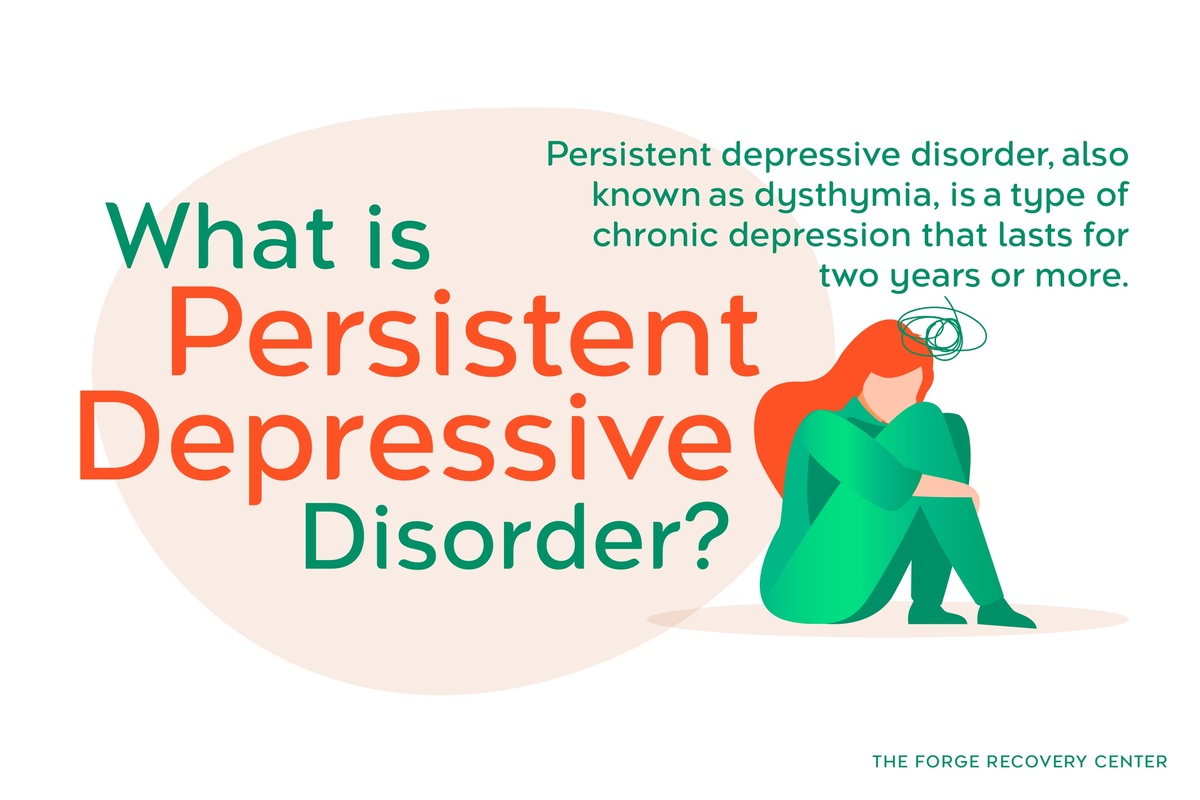Persistent Depressive Disorder: Symptoms, Causes, & Treatment Options


Living with persistent depressive disorder (PDD) can feel like a relentless battle against your own emotions. The persistent cloud of sadness, the weight of hopelessness — it’s a heavy burden to carry. But treatment is available, typically in the form of therapy, medication, and lifestyle changes. Learn more about the symptoms and treatment options for PDD, and call The Forge Recovery Center today if you or a loved one need professional guidance.
What Is Persistent Depressive Disorder?
Persistent depressive disorder, also known as dysthymia, is a type of chronic depression that lasts for two years or more. Individuals with this disorder often experience symptoms such as low self-esteem, fatigue, changes in appetite or weight, feelings of hopelessness, and difficulty concentrating.
Unlike major depressive disorder, persistent depressive disorder symptoms may not be as severe but can still significantly impact a person's quality of life. Treatment for persistent depressive disorder typically involves a combination of therapy and medication to help manage symptoms and improve overall well-being.

Persistent Depressive Disorder Symptoms
Persistent depressive disorder is marked by feelings of sadness and hopelessness that can linger for weeks, months, or even years. It also poses a set of physical symptoms and possible behavioral changes to be aware of, so that you know whether you or a loved one require professional support. Here’s an overview of PDD symptoms:
Emotional Signs
When experiencing persistent depressive disorder, you may notice feelings of sadness, hopelessness, and emptiness. These emotions can linger for weeks or even years. Recognizing these emotional signs is crucial for seeking help and starting treatment promptly.
On some days, the intensity of your emotional signs might be overwhelming, making it challenging to engage in daily activities. At other times, the feelings could be more subtle but persistent. Variations in intensity and duration are common with this disorder, impacting your overall well-being differently.
It's essential to pay attention to these emotional signs as they serve as vital indicators of your mental health. Early recognition allows for timely intervention, preventing further deterioration in your condition. Seeking support from healthcare professionals can lead to effective management strategies.
Physical Symptoms
Apart from emotional distress, persistent depressive disorder can manifest through various physical symptoms like fatigue, changes in appetite, and unexplained aches and pains throughout your body. These symptoms can significantly impact your ability to function normally on a daily basis.
The presence of these physical symptoms can exacerbate the already challenging nature of the disorder. They may lead to disruptions in sleep patterns, decreased energy levels, and difficulties concentrating on tasks. Addressing both the emotional and physical aspects of the disorder is crucial for holistic treatment.
Behavioral Changes
Individuals with persistent depressive disorder often exhibit noticeable behavioral changes such as social withdrawal, irritability, or loss of interest in activities they once enjoyed. These changes can strain relationships with family and friends and hinder performance at work or school.
Managing these behavioral changes requires adopting coping strategies tailored to your needs. Engaging in activities that bring joy, maintaining a routine, and seeking social support are effective ways to combat the negative impacts of these changes on your life. Seeking therapy or counseling can also provide valuable tools for managing behavioral shifts effectively.

Are You Struggling with Mental Health or Addiction?
We Can Help. Call Us Now!
CALL: 877-839-1772
How Is Persistent Depressive Disorder Treated?
Persistent depressive disorder is primarily treated with a mix of therapy, such as cognitive-behavioral therapy (CBT), and medication. Lifestyle adjustments such as eating well and exercising regularly can also help in managing PDD symptoms. Here are the typical treatment avenues for PDD, including comprehensive care at a mental health treatment center:
Psychotherapy
When dealing with persistent depressive disorder, psychotherapy plays a crucial role in your treatment plan. Therapists use various approaches like cognitive behavioral therapy to address negative thought patterns and behaviors that contribute to depression. Through talk therapy, you can explore underlying issues causing your symptoms and learn coping strategies.
Engaging in psychotherapy offers numerous benefits, including improved self-awareness, enhanced problem-solving skills, and the development of healthy coping mechanisms. By regularly attending therapy sessions, you can experience a reduction in depressive symptoms and an overall enhancement in your quality of life.
Medication
In some cases, medication is prescribed as part of the treatment for persistent depressive disorder. Antidepressants such as selective serotonin reuptake inhibitors (SSRIs) or serotonin-norepinephrine reuptake inhibitors (SNRIs) are commonly used to regulate neurotransmitters in your brain associated with mood regulation.
While medication can be effective in managing symptoms, it's essential to be aware of potential side effects such as nausea, insomnia, or sexual dysfunction. Your healthcare provider will closely monitor your response to the medication and adjust the dosage as needed to minimize side effects while maximizing benefits.
Lifestyle Adjustments
Alongside traditional treatments, incorporating certain lifestyle adjustments can complement your efforts in managing persistent depressive disorder. Prioritizing regular exercise, maintaining a balanced diet, and ensuring an adequate amount of sleep are key components in promoting mental well-being.
By engaging in activities you enjoy, practicing relaxation techniques like yoga or mindfulness, and establishing a supportive social network, you can enhance the effectiveness of your treatment plan. These lifestyle changes not only aid in symptom management but also contribute to long-term mental health maintenance.
Mental Health Treatment Centers
Inpatient Care
In more severe cases or during acute crisis situations, inpatient care may be recommended for individuals with persistent depressive disorder. Inpatient treatment programs offer intensive support and supervision to ensure safety and stabilization. The primary goals include crisis intervention, symptom management, and the development of coping skills for future challenges.
Despite misconceptions surrounding inpatient care, these programs provide a structured environment where you receive round-the-clock care from a multidisciplinary team of professionals dedicated to your recovery journey.
Outpatient Care
For individuals requiring ongoing support while maintaining their daily routines, outpatient care serves as a valuable option. Outpatient programs offer flexibility by allowing you to attend therapy sessions or medication management appointments while continuing with work or school commitments.
The supportive nature of outpatient care promotes long-term recovery by providing consistent guidance and resources tailored to your specific needs. This approach emphasizes empowering you to take an active role in managing your mental health over time.
Causes of PDD
Persistent depressive disorder is largely thought to be caused by a combination of genetic, environmental, and psychological factors. Let’s explore these causes further, starting with how your genetic predisposition to depression affects your risk for developing PDD:
Genetic Link
Understanding the genetic link to persistent depressive disorder is crucial. Research suggests that certain genes may predispose individuals to this condition. In other words, if depression runs in your family, you might have a higher risk of developing PDD. This highlights the importance of considering your family history when assessing your own mental health. Ongoing studies are delving deeper into the specific genetic markers associated with PDD.
Environmental Triggers
Various environmental factors can trigger or exacerbate persistent depressive disorder. Stressful life events, such as loss, trauma, or chronic stress, can significantly impact your mental well-being. childhood experiences, like abuse or neglect, may play a role in the development of PDD. Your environment can greatly influence your mental health, so it's essential to be aware of how external factors may be affecting you.
Psychological Factors
When it comes to psychological factors contributing to PDD, negative thinking patterns and low self-esteem are key aspects to consider. Your thought processes and beliefs about yourself and the world around you can influence the onset and persistence of depression. Coping mechanisms and problem-solving skills also play a role in managing symptoms of PDD. Recognizing and addressing these psychological factors is essential for effectively dealing with persistent depressive disorder.
Are You Struggling with Mental Health or Addiction?
We Can Help. Call Us Now!
CALL: 877-839-1772
Dysthymia Vs. Other Conditions
Dysthymia carries similar symptoms to other disorders, such as major depressive disorder, and it’s important to know the subtle yet important differences. Here’s how PDD compares to depression and other mood disorders:
Dysthymia Vs. Depression
When comparing dysthymic disorder to major depression, dysthymia is characterized by milder symptoms lasting for at least two years. Depression, on the other hand, involves more intense symptoms that can impact daily functioning severely.
Living with dysthymia may feel like a constant low mood while experiencing depression can bring about overwhelming feelings of sadness and hopelessness. The persistent nature of dysthymia contrasts with the episodic nature of major depression, where symptoms may come and go.
Other Mood Disorders
Bipolar disorder, a condition involving extreme mood swings from manic highs to depressive lows, differs significantly from dysthymia. While individuals with bipolar disorder experience periods of intense energy and euphoria followed by deep depression, those with dysthymia maintain a consistent but subdued level of sadness.
Another notable contrast lies in seasonal affective disorder (SAD), which is linked to changes in seasons. Unlike the chronicity of dysthymia, SAD typically occurs during specific times of the year, often in winter when daylight hours are shorter.
In comparison to anxiety disorders like generalized anxiety disorder (GAD) or social anxiety disorder (SAD), where worry and fear are prominent features, dysthymia primarily manifests as a persistent feeling of melancholy without the intense anxiety associated with these conditions.
When considering personality disorders such as borderline personality disorder (BPD) or avoidant personality disorder (AvPD), which involve enduring patterns of behavior impacting relationships and self-image, dysthymia focuses more on long-term emotional states rather than pervasive behavioral traits.

Prevalence of Persistent Depressive Disorder
Global Prevalence
When it comes to the global prevalence of persistent depressive disorder, the World Health Organization (WHO) reports that it affects around 5% of the world's adult population. This chronic condition is characterized by long-lasting symptoms that can persist for years.
In developing countries, the prevalence of persistent depressive disorder tends to be slightly lower compared to developed nations. However, the impact on individuals' quality of life remains significant regardless of geographical location. The lack of awareness and access to mental health resources in some regions can exacerbate the burden of this condition.
U.S. Prevalence
In the United States, approximately 2.5% of adults experience persistent depressive disorder at some point in their lives. This condition often begins in adolescence or early adulthood and continues for many years if left untreated. The prevalence rate in the U.S. highlights the need for increased awareness and support for individuals struggling with this chronic form of depression.
Despite advancements in mental health care, many individuals with persistent depressive disorder go undiagnosed or undertreated in the U.S. This underscores the importance of regular screenings and seeking professional help if you or a loved one experience symptoms such as low mood, fatigue, and loss of interest in daily activities.
Are You Struggling with Mental Health or Addiction?
We Can Help. Call Us Now!
CALL: 877-839-1772
Managing Symptoms of PDD
Certain lifestyle changes, the support from your network, and employing stress-reducing strategies can help with managing the symptoms of PDD:
Lifestyle Changes
Making healthy lifestyle changes can significantly impact your experience with persistent depressive disorder. Regular exercise has been shown to alleviate symptoms of depression by releasing endorphins, the body's natural mood elevators. Incorporating nutritious foods rich in vitamins and minerals can also boost your overall well-being.
Engage in activities that you enjoy, such as hobbies or social outings, to help distract from negative thoughts and feelings. Establishing a consistent sleep routine is crucial in managing PDD symptoms; aim for at least 7-8 hours of quality sleep each night. Avoid excessive alcohol consumption and limit caffeine intake as they can worsen depressive symptoms.
Stress Management
Managing stress is essential in coping with persistent depressive disorder. Practice relaxation techniques like deep breathing, meditation, or yoga to calm your mind and body. Set realistic goals for yourself and prioritize tasks to avoid feeling overwhelmed.
Incorporate regular breaks into your daily routine to prevent burnout and allow time for self-care activities. Identify triggers of stress in your environment and work on strategies to minimize their impact on your mental health. Seek professional help if you feel unable to manage stress effectively on your own.
Support From Your Network
Building a strong support system is crucial in navigating the challenges of persistent depressive disorder. Surround yourself with caring and understanding individuals who can provide emotional support during difficult times. Open up to trusted friends or family members about your struggles; sharing your feelings can lighten the emotional burden.
Consider joining a support group for individuals dealing with similar mental health issues; connecting with others who understand what you're going through can be incredibly comforting. Don't hesitate to seek therapy or counseling if you need additional support beyond what your personal network can offer.

Seeking Help & Therapy
Once you’ve recognized the need for treatment, your next step is finding a mental health expert or mental health treatment center that can support your healing journey:
Recognizing the Need
When you find yourself struggling with persistent depressive disorder (PDD), it's crucial to recognize the signs that indicate the need for help. Symptoms such as feeling hopeless, having low self-esteem, or experiencing a loss of interest in activities you once enjoyed are red flags. You might also notice changes in your sleep patterns, appetite, or energy levels.
If you find that these symptoms persist for most days over a period of two years or more, it's time to seek professional support. Recognizing the need for help is the first step toward managing and improving your mental health. Reaching out to a therapist or counselor can provide you with the necessary tools and strategies to cope with PDD effectively.
Finding Professional Support
When it comes to finding professional support for persistent depressive disorder, there are various options available to you. Therapists, psychologists, and psychiatrists specialize in treating mental health conditions like PDD. These professionals can offer therapy sessions tailored to your specific needs and challenges. Support groups can provide you with a sense of community and understanding from others who are going through similar experiences.
Seeking help from a crisis lifeline or helpline can also be beneficial when you are in immediate distress or need someone to talk to outside of regular therapy sessions. These services are staffed by trained professionals who can offer emotional support and guidance during difficult times. Remember, asking for help is a sign of strength, not weakness.
Therapists & Other Mental Health Experts
Therapists: Provide counseling and therapy sessions tailored to your needs
Psychiatrists: Prescribe medication and offer comprehensive treatment plans
Mental Health & Addiction Treatment Centers
Offer specialized programs for individuals dealing with PDD
Provide a range of therapies such as cognitive-behavioral therapy (CBT) and dialectical behavior therapy (DBT)
Are You Struggling with Mental Health or Addiction?
We Can Help. Call Us Now!
CALL: 877-839-1772
Closing Thoughts
Now that you’ve gained insight into persistent depressive disorder, its symptoms, causes, and impact, you’re armed with valuable knowledge to navigate this enduring condition. Early recognition and seeking professional assistance are pivotal in effectively managing PDD. By identifying signs and symptoms early on, you can proactively address them and pave the way for a more fulfilling life.
Empower your mental well-being by staying informed, seeking support from healthcare experts, and building a robust support network. Remember, you’re not alone on this journey. With the right tools and coping strategies, managing PDD is achievable.
Persistent Depressive Disorder Treatment in Orange County
We understand how heavy the symptoms of PDD can feel day by day, even lasting for years for some cases — but you’re not alone, and help is available. At The Forge Recovery Center, our mental health professionals are available to guide you toward mental well-being. And with our set of evidence-based therapies, you’ll be properly supported every step of the way. Contact The Forge Recovery Center today if you or a loved one are struggling with PDD and are in need of professional support.
Treatment Modalities We Offer
The Forge Recovery Center offers a range of proven treatment approaches to aid your healing journey, including:
Case Management
Case management guides clients toward resources that bolster recovery, assessing individual risks to create a comprehensive treatment plan.
CBT
Cognitive behavioral therapy (CBT) helps clients break negative thought patterns and behaviors linked to drug addiction, aiming to prevent relapse and foster a drug-free lifestyle.
DBT
Dialectical behavior therapy (DBT) assists those struggling with emotional instability due to substance abuse, promoting emotional regulation and positive life changes.
EMDR
Eye movement desensitization and reprocessing (EMDR) allows clients to process trauma that may impact their addiction, using eye movement techniques to reduce psychological distress.
Experiential
In experiential therapy, participants can rediscover life’s joys and confront the underlying trauma of addictive behaviors through engaging in therapeutic activities.
Family Counseling
Family therapy strengthens bonds and nurtures a supportive network crucial for sustained recovery and abstinence.
Group Therapy
Group sessions provide a communal space for support, enhancing recovery through shared experiences and collective resilience.
Individual Therapy
Individual therapy sessions address the unique challenges faced by each client, supporting their journey toward a substance-free life.
MAT
Medication-assisted treatment (MAT) combines approved medications with counseling to effectively combat addiction, easing withdrawal symptoms and minimizing relapse risk.
TMS
Transcranial magnetic stimulation (TMS), a non-invasive technique, employs magnetic fields to stimulate the brain, aiding in reducing intense drug cravings.
Motivational Interviewing
Motivational interviewing encourages clients to make healthier choices, such as overcoming cocaine addiction, by fostering self-efficacy.
Trauma-Informed Care
Recognizing trauma’s impact on addiction, trauma-informed care effectively guides clients through treatment, helping them understand its effects on their mental and emotional well-being.



